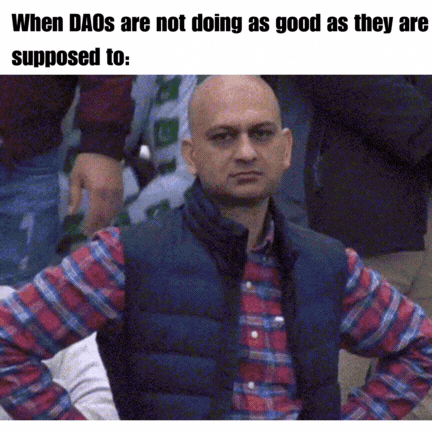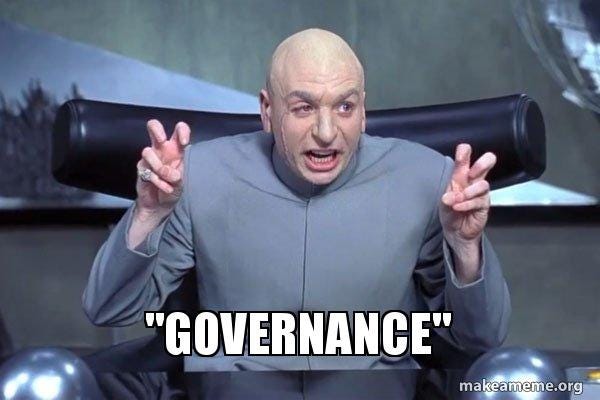Decentralized Autonomous Organizations, acronymed as DAO, cover a variety of web3-based projects. The core idea behind decentralized organizations, about getting rid of centralized authority and handing the power over to the masses, gained popularity faster than expected. Many DAO projects boomed over the tenure of 2020-21: as of now, the number of DAOs extends beyond 4000. While most of them were just mimics of hyped-up internet trends, many had the real potential to bring significant impact in the crypto space.
However, the ongoing bearish atmosphere of the crypto market affected every sphere of web3 developments. Adding to the market conditions, the overall TVL of DAOs reduced significantly, reflecting the community's scepticism and inefficiency of the organizations. Mass adaptation still remains an unreachable destination for most DAOs. Following the present condition of DAOs, it is worth looking into the existing properties of the organizations to address the related challenges.

The Concept of DAO
DAOs emerged from the lacking of the traditional hierarchical structure of organizations. They are an alternative designed to overcome the central authority of an organization. So, the primary condition of a DAO is to have no central leadership. The managerial and organizational rules are constructed by lines of codes written in smart contracts of a blockchain. These smart contracts are the key agents that replace the need for authority to maintain the regulations of the organization. It creates an autonomous managerial process that is able to operate without a third-party intervention and is, ideally, free of human biases. Decisions are made from the bottom up, governed by a community that has agreed upon a specific set of rules enforced by the blockchain. Usually, there are governance tokens for each DAO that allow the holders the power to participate in the decision-making process of the organization. The voting process for DAOs is posted on a blockchain, where users must often select between mutually exclusive options. Voting power is mostly distributed based on the number of Tokens a user holds. For example, one user that owns 100 tokens of the DAO will have twice the weight of voting power over a user that owns 50 tokens.
The theory behind this practice is users who are more monetarily invested in the DAO are more likely to act in good faith unless they want to jeopardize the value of their own holding. DAOs often have treasuries that house tokens that can be issued in exchange for fiat. Members of the DAO can vote on how to use those funds; for instance, some DAOs with the intention of acquiring rare NFTs can vote on whether to relinquish treasury funds in exchange for assets.

Not a Perfect Fit?
While DAOs provide an excellent alternative to the limitations of centralized organizations, they still lack regulatory competence, and the operative discourse still contains significant loopholes. In simpler terms, DAOs are still far from reaching the desirable functionality. Despite handling a whopping $17.2 Billion, most DAOs lack the fundamentals of business management. One does not have to look too far to find traces of DAO failures: The Wonderland DAO, Solana-based trading platform Mango market, and FTX crash being the most recent of the catastrophes are enough to question the infrastructure.
However, the relentless efforts of DAO enthusiasts are something that fuels the idea of achieving perfection. These are some notable challenges that DAOs are yet to overcome on a regulatory and operative basis:
1. Voter Apathy:
DAO governance's most pervasive dilemma is voter apathy. As mentioned earlier, the token holders of a DAO are also responsible for voting. They must cast their ballots to ensure the resilience of the protocols. Yet, a significant number of token holders choose not to participate. The arduous process of voting, coupled with a lack of expertise and context, often discourages active engagement. This scenario has raised concerns about the effectiveness of democratic decision-making within DAOs. Many token holders may remain disengaged, only to realize the importance of their vote when decisions have already been made.
2. Delegate Voting:
To combat the issue of low voter turnout, some DAOs have turned to a concept the concept of delegate voting where token holders entrust their voting rights to representatives, known as delegates. While this approach may expedite decision-making, it introduces its own set of challenges. Delegate voting can sometimes turn into a popularity contest, where token holders assign their votes based on influencers or familiar names rather than expertise. This poses a significant question about the integrity of the decision-making process within DAOs.
3. Growth and Decision-Making:
DAOs are not non-profit organizations. Hence, they must admit to the need for revenue and growth. As DAOs expand and tackle more intricate tasks, the involvement of specialized working groups or experts becomes almost essential. That is why many of them have been experimenting with the concept of "working groups" (also known as subDAOs, pods, core units, or work-streams), which are smaller teams within the DAO structure for handling specific areas of responsibility. However, the introduction of such groups potentially veers DAOs away from their core principle of decentralization, giving rise to concerns about transparency and fairness.

The Governance Conundrum
DAOs definitely offer a solution to the existing problems in centralized corporate institutions. It removes the classic hierarchical governance structure and takes a more democratic approach to decision-making. Despite the commendable traits of decentralization, the current governance models of DAOs are inefficient and still hovering in the experimental stage. Here are a few practices to mind for constructing an effective governance model:
- Clearly define the organization’s mission and objectives
- Develop a clear governance structure
- Foster active member engagement
- Regularly audit and update smart contracts
- Establish risk management protocols
- Maintain legal compliance
- Maintain financial transparency
- Collaborate with other DAOs
- Continuously improve governance processes
For a DAO to succeed, it is crucial that it achieves its governance objectives in a secure, transparent, and fair manner. The fact is not foreign to the existing DAOs too. Owing to several recurring issues of the 1T1V system, DAOs have been experimenting with and exploring more effective solutions. A few notable ones that appeared to replace the traditional voting mechanism include Delegate voting, Holographic consensus, Weighted/ reputation-based voting, and, Quadratic voting. All of them sprouted with the aim of resolving issues of voter apathy, lack of expertise or knowledge on the voter's part, power imbalances, influence of crypto-whales, and, malicious attacks on DAOs. Whether the mentioned voting mechanisms will replace traditional coin-holder voting is still up for debate. Nonetheless, we can expect DAOs to keep reiterating until it lands on a favorable end of the governance issue.

CETS: The Syndicate Framework
Following the failures of DAOs' traditional voting and governance model, CETS announced their new governance model on X (former Twitter) named- "The Syndicate Framework". The model revolves around solving the crises for NFT projects. In justifying the debut of this framework, CETS refers to the core concept of DAOs and retaliates to how the voting mechanism requires users to be very actively engaged with the project's development process. For NFTs, this process of relying upon a large and diverse semi-engaged population, to make every decision, acts as a hindrance to their generally fast-paced and demanding nature. To address this issue, CETS brings forth a hybrid framework, conjuring the traditional corporate executive structure within the best parts of DAO. This framework will enable agile decision-making and execution by a 5 member Executive Team and rely on an Advisory Board to oversee Executive actions and provide checks and balances. Meanwhile, general members will be able to elect the Executive Team, impeach an executive team, and partake in significant decisions that alter the course of Cets. As the thesis of the team entails, the framework is all about the community choosing their leaders and making decisions on behalf of them.
Conclusion
In its current form, DAOs are far from perfect. But the sector is investing in novel governance mechanisms to achieve higher member participation, equitable distribution of power, and efficient decision-making. With the advent of innovative approaches like the syndicate framework's hybrid structure, the community is now looking forward to drifting toward a more effective end. While the technical and regulatory challenges stay stiff in their position, an endless wave of possibilities lies ahead as DAOs strive to overcome them.